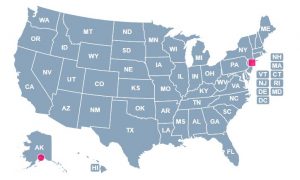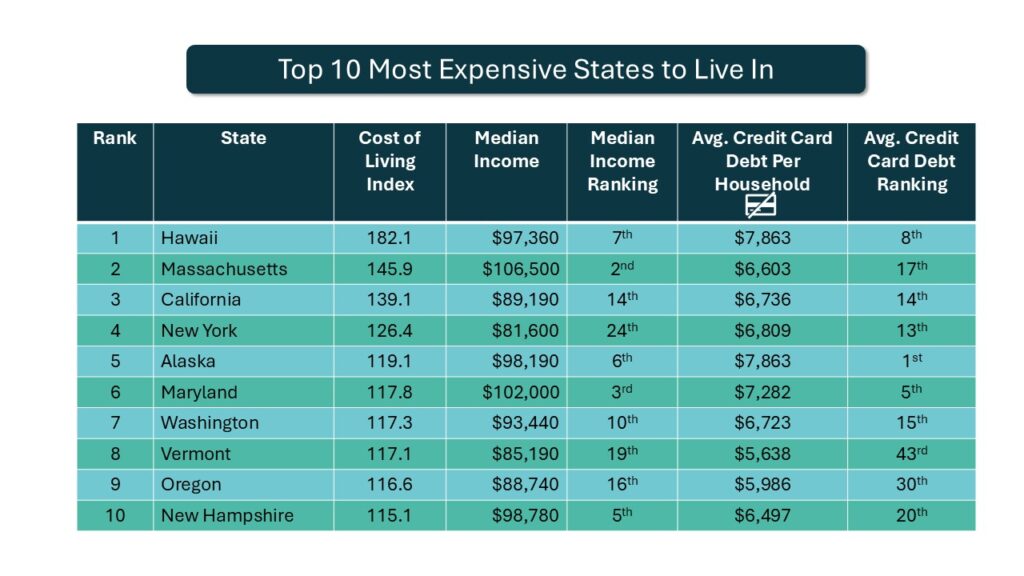It’s hard to ignore how expensive everything has gotten lately.
The cost of living has increased considerably since the advent of the coronavirus pandemic. According to a report by Bloomberg, prices have surged over the last three-to-four years by nearly as much as they did in the decade prior to the pandemic.
Goods that used to cost $100 now cost $120. A dozen eggs used to cost less $2 in 2020. Now the average price is approaching $5. This rapid price increase has put a financial strain on a majority of American consumers. As a result, many feel their salary has not kept pace with inflation.
According to a survey conducted by the Bank of America Corporation in September 2023, 67 percent of Bank of America employees reported they felt inflation was rising quicker and higher than their salaries were, up from 58 percent in 2022, reiterating the stressful impact inflation has had for many Americans.
It seems now more than ever, where you live has a great impact on not just your health and well-being but your finances.
So how expensive is it to live in the U.S. in 2025? Based on the cost of living index, which 20 states are the most expensive to live in?
The 20 Most Expensive States to Live – 2025 Edition

1. Hawaii
Cost of Living Index: 182.1
Hawaii is the most expensive US state to live in, with 82% higher cost of living than the national average in the United States. A key reason why the state has always been expensive is its location, which is 2000 miles southwest of the American mainland in the Pacific Ocean. Most of the basic items in the state are shipped from elsewhere. Moreover, the state has a staggering high housing index of 313.1. Utilities are 51% and transportation 35% more expensive in Hawaii than the national average. Despite ranking #1 on the expensive side, the Aloha state has the 7th highest median income ($97.3K). Nevertheless, the average credit card debt in Hawaii is $6,695 (5th highest).
2. Massachusetts
Cost of Living Index: 145.9
Massachusetts is one of the costliest states to live in the United States, with housing more than twice as expensive as the national average. For every $100 you pay in rent elsewhere in the country, it costs you $218.5 in Massachusetts. The cost of utilities is also 34% higher in the state. The Bay State not only ranks as the second most expensive, but it boasts the second highest income in the nation. The median income in Massachusetts is $106,500. Additionally, the average credit card debt in Massachusetts is $6,077 (19th highest).
3. California
Cost of Living Index: 139.1
California is the third most expensive US state to live in, with its cost of living being 38.5% higher than the national average. Many people want to live here thanks to the gorgeous weather and beautiful scenery. Housing in particular remains pricey, with an index of 198.8. According to a 2022 report in CNBC, the state has a housing shortage of around 3.5 million units, and the number continues to grow each year. The Golden State possesses the 14th highest median annual income at $89.9K. The average credit card debt in California is $6,576 (11th highest).
4. New York
Cost of Living Index: 126.4
Next on our list of the most expensive US states to live in is New York. According to a report, it costs a household of four an average of $6,137 to meet their expenses every month, exclusive of rent. Housing, transportation, utilities, and healthcare in the state are all considerably higher than the national average. Despite having the 4th highest cost of living, the median income ranks 24th at $81.6K. The average credit card debt in New York is $6,313 (17th highest).
5. Alaska
Cost of Living Index: 119.1
The primary reason behind Alaska’s high cost of living is its scarce farmland, comprising less than one million acres, which has meant that much of the food in the state comes from other regions in the United States. Groceries are 23%, utilities 58%, and healthcare 48% more expensive in Alaska than America’s national average. Luckily, the median income ranks 6th in the nation at $98.2K. But the average credit card debt in Alaska is the highest of any state at $7,316.
6. Maryland
Cost of Living Index: 117.8
The cost of housing is surging in Maryland, and in 2023 was 46.4% higher than the national average. Expenses related to groceries and utilities also remain on the higher side. It is one of the most expensive US states to live in. However, Maryland has a median income of $102K which put them as the 3rd highest in the nation. But the average credit card debt in Maryland is $6,787 (3rd highest).
7. Washington
Cost of Living Index: 117.3
While the cost of utilities continues to remain on the lower side, the cost of housing, grocery, transportation, and healthcare has been on a steady rise in Washington for some years now. As a result, its overall cost of index is 16% higher than the national average in the United States. The Evergreen State cracks the top ten in median income at $93.4K annually. While the average credit card debt in Washington is $6,470 (14th highest).
8. Vermont
Cost of Living Index: 117.1
Vermont is one of the most expensive US states to live in with a cost of living index of 117.1. The costliest of all is housing in the state, with an index of 133.1. The price of utilities is also 20% higher than the national average. However, the costs associated with transportation and healthcare tend to hover around the average. The median income is relatively low compared to the cost of living at $85.2K. Vermont ranks as the state with the 19th highest income. However, the average credit card debt in Vermont is fairly low at $5,484 (40th highest).
9. Oregon
Cost of Living Index: 116.6
Next up is Oregon, where the average home price is over $660,000, according to The Observer. What makes the state so costly to live in is its housing, gasoline prices, and the state’s growing reputation as a major business hub – which has led to an influx of well-paid talented professionals from across the country, resulting in higher property prices and rentals. The Beaver State ranks 16th with a median income of $88.7K. The average credit card debt in Oregon is $5,929 (24th highest).
10. New Hampshire
Cost of Living Index: 115.1
New Hampshire completes the top ten most expensive states in the United States to live in. A major cause of this is the surging prices of houses and rental rates, which stem from the state not having enough houses to meet demand. The state’s cost of living index was measured at 115.1 in 2023. Housing and transportation remained between 9-10% higher than the national average, while utilities were 31% higher. The Granite State boasts a high median income of $98.8K (5th highest).

11. New Jersey
Cost of Living Index: 114.2
New Jersey is the eleventh most expensive state in the US to live in, with a cost of living index of 114.2. Compared to the national average, housing is 35.8%, utilities 8.3%, and transportation 4.7% more expensive in the state. The average credit card debt in New Hampshire is $5,953 (22nd highest).
12. Connecticut
Cost of Living Index: 112.1
Housing in Connecticut is around 23% higher than the national average, while the price of utilities is also over 30% more. It is one of the most expensive US states to live in. The average credit card debt in Connecticut is $6,615 (9th highest).
13. Rhode Island
Cost of Living Index: 110.4
While transportation is relatively (7.5%) cheaper in Rhode Island than the national average, expenses related to housing, transportation, grocery, utilities, and healthcare are generally on the higher side. Therefore, the state has a 10.4% higher cost of living index than the United States on the whole and ranks among the costliest states in America to live in. And the average credit card debt in Rhode Island is $6,021 (21st highest).
14. Maine
Cost of Living Index: 109.2
Grocery, housing, utilities, transportation, and healthcare are all between 5-20% more expensive in Maine than the national average in the United States. It is one of the costliest states in the US. And the average credit card debt in Maine is $5,420 (41st highest).
15. Arizona
Cost of Living Index: 107.9
Arizona is among the most expensive US states to live in, with the cost of living close to 8% higher than the national average. Housing in particular is quite costly in the state, having an index of 124.1. However, utilities and healthcare are much more affordable in the state, with indices of 95.3 and 93.8 respectively, according to the Missouri Economic Research and Information Center (MERIC). Additionally. the average credit card debt in Arizona is $6,317 (15th highest).
16. Colorado
Cost of Living Index: 105.6
The cost of living in Colorado is nearly 6% higher than the national average in the United States. According to the Colorado Property Group, the cost of living per year in the state is approximately $53,374. One area of respite for the consumers is utilities, which are around 9% cheaper than the national average. Additionally, the average credit card debt in Colorado is $6,574 (12th highest).
17. Utah
Cost of Living Index: 103.4
Next on our list of the most expensive US states to live in is Utah, where according to Expatistan, a family of four has an average monthly expense of $5,162. It is one of the costliest states in the country, with housing nearly 11% higher than the national average in the United States. Healthcare, however, is cheaper in the state; a medical bill of $100 anywhere else in the country would only cost $91 in Utah. And the average credit card debt in Utah is $5,945 (23rd highest).
18. Montana
Cost of Living Index: 103.1
Montana is among the most expensive US states to live in. A transport ride that costs $100 elsewhere in the US would cost 9% higher in the state. Housing and grocery prices are also on the higher side in Montana. Utilities, however, are on the cheaper side in the state, costing 7.5% lower than the national average in the United States. And the average credit card debt in Montana is $5,728 (30th highest).
19. Virginia
Cost of Living Index: 102.9
Next is Virginia where the cost of living is nearly 3% higher than the national average. However, this is offset by the state’s annual median household income of $87,249, which is approximately 17% higher than the national median household income per annum in the United States. And the average credit card debt in Virginia is $6,647 (7th highest).
20. Delaware
Cost of Living Index: 102.1
And finally, Delaware, where the overall cost of living is slightly higher than the United States on a whole. Grocery, transportation, and healthcare is particularly expensive in the state, while housing and utilities are on the lower side compared to the national average. And the average credit card debt in Delaware is $6,314 (16th highest).
Average debt amounts per state according to Visual Capitalist.
Is credit card debt ruining your personal finances? Then look into Debt Consolidation to help free up cash flow and lower interest rates.




Life’s a bitch and then you die!
This is so very very true about the state of New Jersey it’s extremely difficult to live here in your senior years with the very very high cost of living every one is trying hard to get out asap
I’m in Washington, we our out of control with the mass people moving here!
Traffic is a complete nightmare every day!
We are voting to raise our taxes! Nobody in this state can balance the budget!
We have lawlessness everywhere crime is bad! They are going to tax us out of our homes! I’m kinda feeling like California! Our Governor is modeling after Newsom!
They want more money to care for the illegals/refugee’s! And the American Taxpayers to pay for it!
Here in oregon, the whole state is judged and controlled by Portland and the six or seven liberal counties surrounding it, whatever they do effects all of Oregon. They say it’s because Oregon is a big business hub. I don’t know what big business hub they are talking about. Businesses are leaving this state. The taxes and regulations are killing businesses. But yet prices on everything are high. We don’t have a sales tax in this state you would think we would be doing much better. But they raise the other taxes so high to make up for no sales tax that businesses cannot make it here.